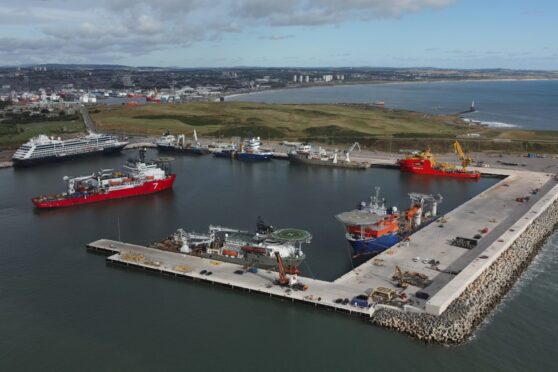As the world transitions towards a more sustainable future, Scottish ports have a generational opportunity to be drivers for economic growth, energy security, and decarbonisation.
-
Some Press and Journal online content is funded by outside parties. The revenue from this helps to sustain our independent news gathering. You will always know if you are reading paid-for material as it will be clearly labelled as “Partnership” on the site and on social media channels.
This can take two different forms.
“Presented by”
This means the content has been paid for and produced by the named advertiser.
“In partnership with”
This means the content has been paid for and approved by the named advertiser but written and edited by our own commercial content team.
Port of Aberdeen’s transformational £420million South Harbour expansion offers the project space and additional quayside to complete offshore wind construction. Combined with the existing North Harbour’s unrivalled capacity and history of supporting offshore operations and maintenance (O&M), Port of Aberdeen is project ready for offshore wind.
Public and private sector partnership could position the port as the leading hub for sustainable offshore wind operations, driving Scotland towards a greener future.
The opportunity
Scottish Development International published that Scotland has over 45 gigawatts of offshore wind projects in the pipeline and a 2023 report from the Floating Offshore Wind Taskforce found that a minimum of three to five ports in Scotland will need to be transformed into new industrial hubs to ensure they are ready for the mass deployment of floating wind by 2030.
While Scotland’s port infrastructure is robust, substantial upgrades are required to handle the large turbines, such as those at Moray West, which will reach 285 meters high.
With more than 160 floating wind turbine designs currently on the market, ports face the challenge of planning infrastructure investments to enhance their capacity and capability without clarity on what future projects will require in terms of quayside length, depth, and laydown area.
To unlock the full potential of Scottish ports in the offshore wind sector, streamlined regulatory and planning processes are essential. Bureaucratic hurdles and delays could dampen investor confidence and hinder projects, turning ports from key enablers into obstacles.
Beyond clean energy, developing offshore wind infrastructure can stimulate economic growth, create jobs, and revitalise coastal communities. By fostering skills and technological advancements, Scottish ports can become global leaders in offshore wind.
Collaboration between the public and private sectors is crucial to secure the funding needed for port upgrades and expansions, ensuring Scotland maximises this opportunity.
Port of Aberdeen
In Aberdeen, the South Harbour expansion project underscores the port’s commitment to this sector. A proposed £25m dredging project is poised to make the port fully ready for floating offshore wind and is a tangible example of where industry and government cooperation is needed to support the North East’s Just Transition and the nation’s offshore wind ambitions.
North Harbour will also see investment to transition facilities at North Harbour to support offshore wind O&M, priming Port of Aberdeen to be the leading O&M hub in Scotland.
Port of Aberdeen and other leading ports from across Scotland launched the Scottish Offshore Wind Ports Alliance (SOWPA) earlier this year. SOWPA is a progressive and collaborative forum of the country’s leading infrastructure facilities, targeted at optimising the opportunities from offshore wind.
SOWPA is represented by leading offshore energy ports across Scotland, which hold expertise across the full offshore wind value chain, from manufacturing and fabrication, through to marshalling, assembly, and operations and maintenance.
The alliance is actively developing opportunities to enhance regional competitiveness, drive efficiencies and fast track the required expertise to support the UK’s burgeoning offshore wind industry.
The future
As Scotland works towards achieving net zero emissions by 2045, ports are at the forefront of this journey, serving as the central point in the nation’s energy transition and shaping the broader landscape of Scotland’s energy sector.
It’s imperative that the public and private sectors unite to secure the necessary funding for port enhancements and expansions, alongside forward-thinking policies, and collaborative efforts. Scottish ports have the opportunity to become powerful enablers of the next generation of offshore wind, driving Scotland towards a greener, more prosperous future.

Conversation